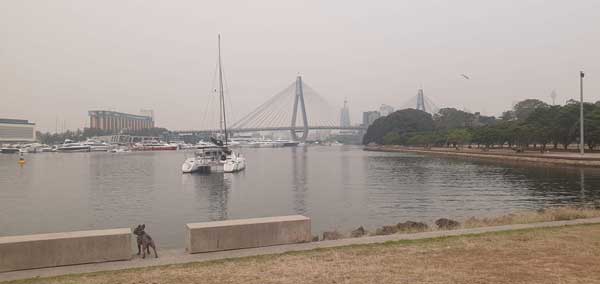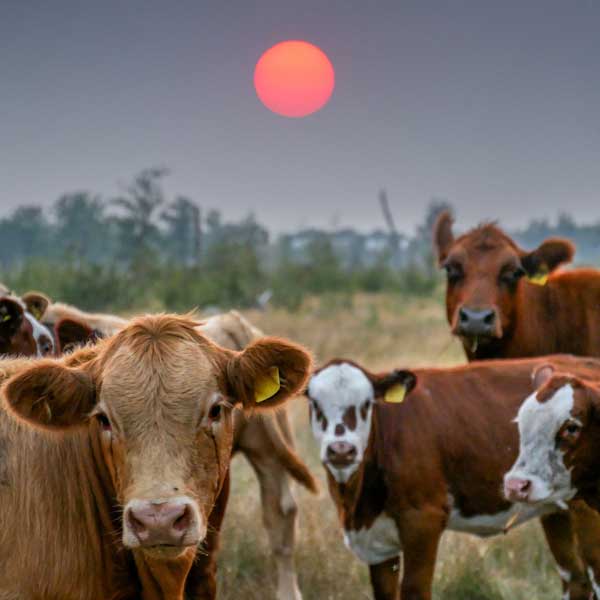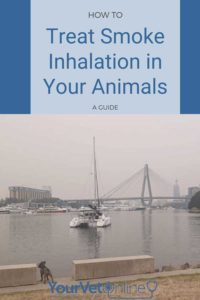Dangers Of Smoke Inhalation For Pets, Horses & Livestock
Whether your animals have been in a house fire, bush fire or they are in an area where smoke haze has blown in, smoke inhalation for pets, horses, and livestock can result in significant health problems.
In this article, we share the precautions you can take to limit your pet’s exposure to smoke and minimise health effects.

[easy-social-share]
If you are feeling the effects of inhaling smokey air, it’s likely that your animals are too.
All animals whether cats, dogs, horses, birds, livestock, or wildlife can suffer from breathing issues when exposed to smoke pollution.
While the type of chemicals found in smoke does depend on the substance that has been burned, it’s safe to say that all smoke contains a mixture of particulate matter and other chemicals such as carbon monoxide that is produced by the incomplete burning of carbon-containing materials.
The two main agents in smoke that cause the most harm to both people and our pets are carbon monoxide and particulate matter, sometimes known as PM2.5.
These particles are extremely small i.e. 2.5microns or less in size and are easily inhaled resulting in inflammation of lung tissue.
What Does Smoke Inhalation Do To Our Pets?
When the very small particulate smoke particles enter the body via the airways they are treated as a foreign object and the body alerts an inflammatory response to try and remove them.
Signs that your pet may be exerting an inflammatory response to smoke includes:
- Weeping eyes, nose
- Cough
- Reverse or normal sneeze
- Wheezing
The effects of carbon monoxide (CO) can take days to notice, but when it does occur the effects are drastic.
Carbon monoxide affects the body’s ability to deliver oxygen to tissues. When the body is unable to circulate oxygen adequately you may notice the following signs:
- Incoordination
- Sleepiness
- Seizures
- Bright red mucous membranes
Symptoms From Breathing In Smoke
The main signs that your pet, horses or livestock may be feeling the effects of smoke inhalation include:
- Weeping eyes/nose
- Harsh cough
- Reverse sneeze
- Increased breathing rate
- Increased depth of breath, gasping/wheeze, abdominal breathing
- Open mouth breathing (especially cats and birds)
- Bright red, blue or pale coloured gums
- Incoordination
- Depression
- Seizures
- Foaming at the mouth
The effects of smoke inhalation are cumulative and may not necessarily be noticeable straight away.
For example, animals that have breathed in a lot of smoke may start to get swelling of the laryngeal structures at the back of the throat. This can lead to occlusion over time.
Normal Respiratory Rate (breathing rate)
- Dog 15-40 breaths per minute ave 24bpm
- Cat: 20-30 bpm
- Bird: smaller birds (<300g) from 30−60 bpm and in larger birds (400–1,000g) from 15–30 bpm.
- Horse: 8-12 breaths per minute.
- Rabbit: 30-60pbm
- Guinea Pig: 40-150 average 90bpm
It is important that if you notice that your pet is struggling to breathe, you get them to a veterinarian sooner rather than later to avoid finding that your pet is in deep trouble.
The most important sign to look for is breathing rate and effort.
If your pet is struggling to breathe – go to the vet immediately
How To Count Breaths
The easiest way to determine how fast your pet, horse, or any other animal is breathing, is to simply observe them when they are calm and relaxed and count the number of breaths per minute.
To learn how to take your pet’s breathing rate, check out our article on normal vital signs.
Alternatively, count the number of breaths taken in a 15 second period (you’ll need a watch with a second hand) and then multiply this number by four to get the number of breaths taken per minute.
If your animal is really struggling and is breathing with greater effort than normal you may see the abdominal muscles (stomach region) moving forcefully in and out with each breath.
The chest wall and ribs will move further with each breath.
You will often hear us talking about animals ‘open-mouth’ breathing.
Cats, birds, horses, rabbits, and guinea pigs don’t breathe through an open mouth.
If you notice open mouth breathing this means that they are highly stressed/hot/struggling to breathe. They need to see a vet.
These animals often will puff/billow out their cheeks with each expiration, stand with legs in a wide stance, or neck outstretched.
Remember that some animals, especially cats will want to hide the fact that they are struggling. Often they will interact less with you, go and hide in a closet, or just not act like themselves.
Dogs will pant.
Any animal with carbon monoxide CO poisoning will have bright red mucous membranes.
Gums that are pale or blue/grey/muddy indicate shock and lack of blood circulation of oxygenated air. This is an emergency.
You can listen to this quick (4min) video of Dr Leigh sharing some tips to keep your animals safe.
How To Tell If Your Animal Needs To See A Vet?
A very rough guide:
Urgent Requirement For Vet Care
- Rapid or deep breathing
- Cats/birds etc – open mouth breathing
- Lack of coordination
- Bright red or blue gums
General Care For All Animals – Monitor At Home
- Limit exercise
- Keep pets inside.
- Close windows and doors.
- Use aircon and recirculate air.
- Make sure filters are clean & high quality.
- Humidify the air
What Species Or Breeds Are Most Susceptible To Smoke Poisoning?
Certain animals and breeds appear to have less tolerance to inhaling smokey air than others.
Birds
The most susceptible animal to changes in air quality and the toxic effect of smoke are birds.
Birds have relatively small lungs and air sacs that play an important role in respiration. The flow of air and oxygen exchange occurs between air capillaries and blood capillaries rather than with alveoli as in mammals.
This provides for far more effective gas exchange, which in turn, makes them highly susceptible to air pollution.
Birds that are struggling to breathe will often have their beak open ie.. open mouth breathing.
Brachycephalic Dogs and Cats
Brachycephalic dogs and cats are also prone to respiratory problems due to their short face and often occluded nasal and laryngeal areas. Toxic fumes from smoke inhalation just exacerbate their present condition.
Animals With Chronic Airway Conditions
Animals that have pre-existing problems such as asthma, chronic bronchitis, cat flu, heart disease may also find it a struggle to breathe during periods of high smoke haze.
Overweight Animals
Fat cats and fat dogs also have higher oxygen demands than their slimmer counterparts. Combine this with toxic fumes from smoke, then it’s a recipe for respiratory distress.
Outside Animals
It’s also wise to remember our pets that are often kept outside, such as rabbits, guinea pigs, horses, and other livestock.
If the smoke pollution is high, it’s impossible for them to escape. Ash may also contaminate their water and feed as well as settle on their coats where they will lick it off during grooming.
How Can You Assist Your Pet or Livestock When There Is Smoke Pollution?

It is important to protect your pets and animals from the effects of smoke inhalation. You can do this by avoiding smokey areas.
- Bring pets inside and close doors and windows. Keep birds well away from windows and doors.
- Use aircon to recirculate inside air rather than drawing air from outside.
- For livestock and horses, provide shelter and ensure that water and feed are clear of particulate matter. Consider wetting down dusty areas and dry foods.
- When air quality alerts are high don’t exercise and only let animals out for toilet breaks.
- Even though exercise is essential, be smart and only exercise at times when smoke pollution is at its lowest.
- Remember that smoke damage to the lungs can take a good 4-6 weeks to recover from. Don’t push animals to exercise immediately once the air clears.
- Consider giving your animals some time in humidified air. This provides moisture relief to dry airways and eyes.
- An easy method is to have your pets join you in the bathroom when showering with the doors and windows closed.
- Dry eyes can be moistened by over the counter human eye moisture drops.
- Choose a brand that has no steroid and/or antibiotic.
Emergency Care For Pets With Signs Of Smoke Inhalation
All animals struggling to breathe must see a vet for supportive oxygen care. But if you are unable to get to a vet immediately, there are some things you can do:
- Place your pet near a humidifier or in a steamy room (bathroom).
- Place a wet cloth over their face (eyes and nose) to assist with increasing moisture if you are surrounded in smoke.
If your animal is not taking adequate breaths and requires rescue breathing, follow this procedure to help breathe for and ventilate the animal:
For Dogs:
- hold the animal’s mouth closed,
- cup your hands around the mouth to ensure a good seal
- place your mouth around their nose and breathe at the dog’s normal respiratory rate i.e. about 24 breaths per minute.
For cats, rabbits, guinea pigs other small animals:
Give rescue breaths directly into the mouth and nose at the same time.
In all animals, watch for chest rise and fall to ensure that you are giving strong enough breaths to inflate the lungs.
Often it is impossible to avoid pollution from smoke. In these cases, it is wise to stay observant, limit stress (that includes exercise) and monitor your pets and other animals for any sign that they need more care than you can offer. It is far better to get veterinary advice before a disaster occurs, you can talk to one of our vets by clicking on the button:
Yes, I’d like to speak with a vet







Leave A Comment